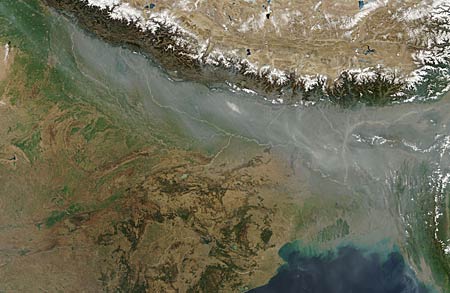 |
This satellite image shows a pale band of haze over northern India, southern Nepal and Bangladesh. Research suggests that reducing such air pollution could increase agricultural harvests.NASA photo. |
Auffhammer, along with V. "Ram" Ramanathan and Jeffrey Vincent, both researchers at UC San Diego, analyzed historical data on Indian rice harvests and found that harvests would have been 20 to 25 percent higher during some years in the 1990s if certain negative climate impacts had not occurred.
Rice harvests increased dramatically in India during the "Green Revolution" of the 1960s and 1970s, making the country self-sufficient in its staple food. But harvest growth has slowed since the mid 1980s, raising concerns that food shortages could recur in this densely populated and poor nation. Several explanations for the slowdown have been proposed, but until now, none took into account the complex interactions of two pollution-related sources of climate change: atmospheric brown clouds (ABCs), which form from soot and other fine particles in the air, and the better-known problem of global warming, caused by greenhouse gases such as carbon dioxide.
Previous research by an international scientific team led by Ramanathan, who is also a professor of atmospheric sciences at Scripps Institution of Oceanography, found that brown clouds have made the Indian subcontinent drier and cooler. Although this suggests the existence of a climatic tradeoff, with reductions in aerosols potentially unleashing a stronger warming trend, the current study indicates that joint reductions in the two types of pollutants would, in fact, benefit Indian rice farmers. This is because reductions in aerosols would enhance rainfall, while reductions in greenhouse gases would reduce the higher nighttime temperatures that can negatively affect the growth of the rice plant.
"Greenhouse gases and aerosols in brown clouds are known to be competing factors in global warming," said Ramanathan. "The major finding of this interdisciplinary study is that their effects on rice production are additive, which is clearly an unwelcome surprise."
Auffhammer notes that "while this study focuses on India's rain-fed states, ABCs exist throughout Asia's main rice-producing countries, many of which have experienced decreasing growth rates in harvests, too. Furthering our understanding of how air pollution affects agricultural output is very important to ensure food security in the world's most populous region."
--Sarah Yang
